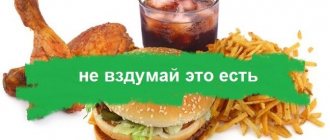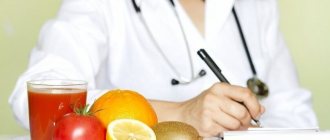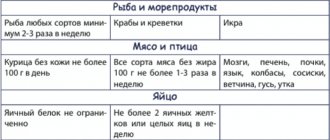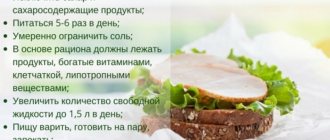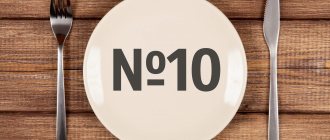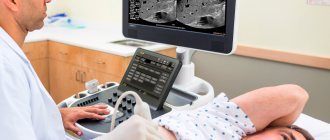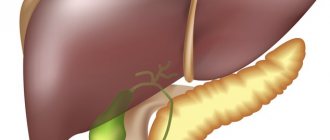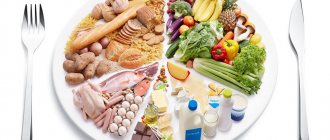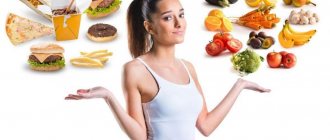The number of patients suffering from liver diseases is increasing every year.
The causes of an acute condition in liver diseases can be:
- Eating disorders;
- Development of infections in the peritoneum;
- Hereditary genome;
- Consequences of drug treatment, etc.
In this case, an immediate treatment package is required, which necessarily includes a diet that promotes a speedy recovery, alleviation of the condition and relief of pain.
When is the diet prescribed?
The main function of cookies is the process of cleansing the body and removing toxins, salts, and heavy metals.
After prolonged use of antibiotics in treatment, excessive consumption of strong alcoholic beverages or fatty, heavy foods, the protective functions of the liver are significantly reduced and it simply cannot clean and filter food.
With high immunity, liver diseases can occur in a latent form and not bother the patient for many years.
After stress, severe stress, hypothermia or the development of viruses, acute pain can be provoked in a vivid form by symptoms of exacerbation of hepatic colic.
Indications for prescribing dietary nutrition may include the following liver diseases and human conditions:
- Pathologies of the intestines and liver;
- Cholelithiasis;
- Chronic hepatitis;
- Cholecystitis;
- Period of exacerbation of steatosis;
- Acute forms of diseases;
- Cirrhosis of the liver.
Dietary nutrition and restrictions on the consumption of various foods will be relevant if pain develops in the area of the right hypochondrium, liver, and indigestion occurs.
Table No. 5: principles
During the appointment, the endocrinologist must give the patient a reminder for organizing nutrition in accordance with the standards for liver pathologies.
The more accurately the patient adheres to the rules, the lower the load on the affected organ , and the lower the risk of exacerbations in chronic diseases.
In the acute form of the disease, when the patient has constant pain, a diet and a properly selected menu reduce the impact on the organ and prevent negative changes in the cells. With proper nutrition, the patient recovers more quickly and the disease does not become chronic.
Diet principles:
- fractional meals (small portions, eating 5 or 6 times a day);
- refusal of fried, fatty, smoked foods;
- food should be warm. Hot and cold foods worsen the condition;
- minimum salt and sugar;
- products containing a lot of fiber are required: non-acidic fruits, vegetables, bran;
- Steaming or regular cooking, baking, stewing of dishes is recommended;
- avoidance of large pieces, coarse, poorly digestible food is required;
- Adequate amounts of protein support liver health. Low-fat dairy products and turkey meat are optimal;
- acidic foods are not recommended. The ban applies to vegetables, fruits, leafy greens, citrus fruits, natural juices, carbonated drinks;
- vegetable fats are healthy in moderation; lard, lard, lamb, and beef fat are prohibited;
- A sufficient amount of fluid is a mandatory item in diet No. 5 for pathologies. Jelly, unsweetened green tea, and still mineral water are recommended. Clean water is required throughout the day - up to one and a half liters.
Do you know the health benefits and harms of chokeberry? We'll tell you!
Our article will tell you about the benefits and potential harm of apricot kernels.
The beneficial properties of cherry leaves are discussed in detail in our review.
Principles of adherence to therapeutic nutrition
Diet and limited nutrition for diseases that attack the liver are focused on providing the liver with rest, a period for recovery, in order to normalize the functions of the biliary system.
Such a gentle dietary menu for diseases affecting the liver includes a normal level of consumption of fats and carbohydrates necessary to support the functions of the body, but not enough to cause harm:
- Without fail, experts recommend minimizing the level of fat consumption when dieting.
- Diet menu recipes should be steamed or baked in the oven. But at the same time, no frying in sunflower oil; it is necessary to exclude grilling and stewing from the diet.
- It is advisable to use soft foods or grind all the ingredients on a fine grater so that solid foods do not damage the inflamed intestinal walls. If the recipe uses meat, you need to choose dietary low-fat varieties, without lard and streaks.
- Diet dishes for liver diseases should be warmed to room temperature; cold and hot foods can provoke a new attack or the development of pain.
- In case of liver diseases, it is under no circumstances recommended to use products for cooking with a high content of oxalic acid, purine, or fiber. Otherwise, there may be bloating, acute pain in the hypochondrium, and flatulence. The presence of coarse fiber in the diet menu can cause excessive secretion of digestive juices.
- The total amount of food consumed per day should be divided into 5-6 meals, in small portions.
- In the morning on an empty stomach, you need to drink a glass of liquid: pure water or medicinal herbs to stimulate intestinal function and relieve inflammation.
As a result of all dietary measures, the patient should have the following daily diet:
- The numerical indicator of proteins should not be more than 80 grams, half are products of animal origin.
- The fat level is allowed up to 80-90 grams.
- Experts advise increasing carbohydrates to 500 grams. per day.
- Consume at least 2 liters of fluid per day.
- Be sure to minimize your salt intake; as a result, no more than 10 g are allowed per day.
Doctors recommend!
Monastic stomach tea - for gastritis, ulcers, heartburn and for general health promotion!
Find out more>>>
Dietary considerations for liver disease
The most common liver diseases are liver failure, hepatitis, cirrhosis, fatty liver, toxic liver injury, including alcoholic liver disease and liver cancer.
In case of liver failure, a low protein and low fat diet is used. Its goal is to reduce the production of protein-related metabolic products of the body and protect the organically damaged body. At the same time, it is necessary to provide the body with the necessary amount of energy and nutrients.
For example, a 2000 kcal diet for liver disease should contain 20-40 g of protein, 20-25 g of fat and 400 g of carbohydrates. Protein provided must be 75% animal sourced and spread across three meals. Carbohydrates are mainly grain products made from refined flour.
Proteins, fats, carbohydrates are essential components of a healthy diet.
An easily digestible, fat-restricted diet is recommended not only for fatty liver disease, but also for various other diseases of the pancreas, gallbladder and bile ducts. This type of diet is also used after abdominal surgery and for liver diseases without severe organ failure. The diet limits the amount of fiber and, above all, the amount of fat to 40-50 g per day. Fat reduction is necessary in case of bile stagnation and suppression of bile secretion, impaired digestive enzyme secretion and exacerbation of chronic hepatitis.
The recommended amount of protein should correspond to the physiological norm or be slightly increased. Its consumption is assumed to be at the level of 1-1.2 g/kg body weight, and not less than 0.8 g/kg. Carbohydrates provide most of a person's energy. In a 2000 kcal diet, fats are 45-50 g, proteins 70-90 g and carbohydrates 300-350 g.
In case of chronic liver disease without complications, a diet similar to the main one is used. However, it is necessary to take into account the recommended cooking methods in the diet and avoid eating foods that cause digestive problems.
Allowed foods for diet for liver diseases
In order to correctly formulate a dietary plan for diseases affecting the liver, it is recommended to listen to the recommendations of specialists.
Experienced gastroenterologists allow the following products to be included in the menu:
- Potato;
- Pumpkin;
- Apples;
- Bananas;
- Prunes;
- Strawberry;
- Rice;
- Oatmeal;
- Pearl barley;
- Cottage cheese 1%;
- Honey;
- Chicken eggs;
- Rabbit;
- Turkey;
- Chicken fillet;
- Pollock;
- Hake;
- Cod;
- Mineral water;
- Carrot juice;
- Rosehip juice.
Basic diet rules
Before studying the features and rules of the diet for liver diseases, it is worth noting that the nutritional plan should be drawn up and prescribed exclusively by an experienced doctor. It is used for various forms of hepatitis, cholecystitis and cirrhosis. The diet makes it possible to get rid of unpleasant heaviness in the area of the right hypochondrium, and also significantly improves overall well-being.
If you follow all the doctor’s recommendations, you can get truly incredible results - reduce the severity of unpleasant symptoms and enhance the effect of medications. In approximately 70% of cases, a positive effect is achieved within approximately 2-3 treatment weeks.
If a person continues to consume fatty and other prohibited foods, a lot of alcohol simultaneously with medications prescribed by a doctor, it will be difficult to achieve the desired result in treatment. Even if a positive effect is obtained, it will be short-lived. If you follow all the rules of nutrition and give up bad habits, you can not only get a positive effect, but also eliminate the chronic course of the disease. The patient's exacerbations will be minimized, and it is also possible to effectively prevent the manifestation of painful symptoms of the pathology.
Important! Proper nutrition allows you to completely get rid of the problem, avoid various unpleasant complications and transform the disease into a chronic form.
So, what nutritional rules should you follow when following a diet for liver diseases:
- Only fractional meals throughout the day are recommended. Frequent consumption of food in small volumes allows you to completely normalize the process of bile production, and strictly at a certain time. Small meals will prevent thickening and stagnation of bile juice, as well as minimize the likelihood of stone formation;
- It is important to completely avoid fatty, overly fried, salty and smoked foods. In addition, the condition of the organ and overall digestion are negatively affected by excessively cold and very hot dishes;
- You should enrich your daily diet with plenty of fiber. It is important to consume vegetables and bran;
- It is necessary to pay close attention to cooking methods. Products should be baked, boiled and stewed. It is imperative to avoid coarse pieces of food, grinding the food until it becomes mushy;
- You need to include more protein in the menu - meat, fish and low-fat dairy products;
- The amount of fat must be carefully controlled. Products such as fatty lamb and lard are strictly prohibited; only high-quality vegetable oil is allowed.
It is very important to maintain the proper level of water and electrolyte balance while following a diet. To speed up the process of removing harmful toxins from the body, you need to drink at least one and a half liters of water every day. The required amount of liquid can be replenished with jelly, green tea and still mineral water.
Prohibited foods for the diet for liver diseases
There are also a number of strict dietary restrictions in the diet for liver diseases.
This is a list of foods that can stimulate an exacerbation, new attack or adverse symptoms:
- Canned vegetables;
- Bulb onions;
- Peas;
- Horseradish;
- Beans;
- Nuts;
- Mushrooms;
- Grape;
- Dumplings;
- Pasta;
- Baking;
- Confectionery;
- Ice cream;
- Chocolate;
- Mayonnaise;
- Mustard;
- Smoked sausage;
- Smoked meats;
- Cream, sour cream, full fat;
- Salo;
- Pork;
- Salmon;
- Canned fish;
- Duck;
- Goose;
- Alcoholic drinks;
- Soda water;
- Coffee;
- Cola.
TOP 5 most beneficial foods for the liver
There are foods that are allowed to be consumed if you have liver problems. But there is also food that has a beneficial effect on the organ, stimulates cell renewal and restoration, and has a therapeutic effect.
The most useful diet foods for liver inflammation:
- Pumpkin. Helps cleanse the liver, helps lose weight, has a positive effect on the entire gastrointestinal tract, and reduces cholesterol.
- Laminaria is also known as seaweed. Contains iodine and antioxidants, which are necessary for proper liver function. But it is important to use non-pickled seaweed.
- Dried apricots. Dried apricots cleanse the liver of toxins and waste and have a beneficial effect on liver function.
- Carrot. This product has a choleretic effect, contains carotenes and vitamins necessary during a diet for liver problems. Reduces the toxic effects of drugs of antibacterial groups.
- Beet. Betaine, which is contained in this vegetable, stimulates liver function and cell renewal.
All products are prepared and consumed according to the general rules of the diet. Vegetables or seaweed should not be used fried or marinated with hot sauces and spices.
What diet for liver disease?
There are a huge variety of diets; it is necessary to choose the most effective one depending on the individual characteristics of the course of liver diseases.
Strict diet
To reduce the accompanying symptoms of liver disease and alleviate the condition, it is recommended to include products such as:
- Probiotics, expressed in nature by natural fermented milk products, will help the liver and stomach function well.
- Eat more fiber , and to do this, add allowed vegetables and fruits to the menu. Ground flax seeds, which can be eaten between main meals, as a light snack, have a good effect.
- To create optimal microflora that promotes a speedy recovery, artichokes, chicory root, soy, dandelion greens, and asparagus are isolated.
- Whole grain products, such as rice, oatmeal and buckwheat, are considered mandatory for a liver-friendly diet
- As a drink, it is recommended to use wheat sprouted juice , a fresh cocktail made with spinach, and green salad. This will saturate the body with essential vitamins and minerals.
- In order to improve the fermentation and digestion of food during the period when the liver cannot fully perform its functions, a B vitamin is needed.
- Exclude baked goods, confectionery, fatty and heavy foods. Of course, you should not drink strong alcohol throughout the entire treatment period; it is advisable to categorically not use tobacco products.
In general, diets are recommended to be followed throughout the entire period of therapy and to consolidate the effect obtained for another month after recovery.
Gentle diet
Dietary nutrition, in which loose restrictions on the choice of products and cooking recipes is aimed at creating sufficient (insignificant) activity of the secretory function of organs.
To do this, it is recommended to include juice recipes, herbs, and dishes in the daily food menu:
- Hot recipes made independently based on dietary meat and sea fish. Sour soup with pureed vegetables is well accepted by the stomach.
- Cereals cooked in low-fat broth from dietary meat, except millet and pearl barley.
- Vegetable stew.
- It is allowed to eat salads with tomatoes, boiled and chopped onions, and sour sauerkraut.
- To help the intestines, it is important to drink fermented milk products, eat grated cheese, yogurt, and yogurt.
- Strong black tea with lemon, cocoa, drink juices only with water.
Be sure to exclude:
- fresh baked goods;
- any bakery products;
- legumes;
- smoked meats;
- pickled vegetables;
- pickles;
- pepper;
- mustard;
- horseradish.
Products can be introduced gradually only when improvement occurs. For liver diseases, it is also recommended to include foods that have a choleretic effect in the menu. These include vegetable oils, watermelon, beets, turmeric, and avocado.
Atkins diet
The advantage of the Atkins Diet for liver dysfunction is the fact that it is quite balanced and satisfying.
The Atkins diet for patients suffering from liver disease is designed for 14 days:
| Day | Menu |
| 1st day |
|
| 2nd day |
|
| 3rd day |
|
| 4th day |
|
| 5th day |
|
| 6th day |
|
| 7th day |
|
| 8th day |
|
| 9th day |
|
| 10th day |
|
| 11th day |
|
| 12th day |
|
| 13th day |
|
| 14th day |
|
Diet 5 for liver disease
Diet “No. 5” is an excellent way to improve the health of the body and provide a gentle regime for the liver and stomach. You need to stick to this diet for at least 5 weeks until complete recovery.
The basic rules of the diet for liver diseases, which should be strictly followed:
- Under no circumstances should you eat hot or too cold food.
- All food should be pureed or very chopped mass.
- It is better to steam meat recipes and try to completely avoid fried foods.
- Dried fruit compotes have an excellent effect on the intestines.
- To drink, choose green tea and rosehip decoction.
- The diet not only helps the functioning of the stomach, but also helps to lose excess weight.
- Replace sugar in your daily menu with honey.
- Once a week, have a fasting day and drink only kefir.
Diet after liver surgery
After liver surgery, experts recommend following a diet for at least 2-3 months:
- In this case, in order not to burden the digestive system, you should avoid pickles, spicy dishes, smoked meats, fried foods, ice cream, lemons, legumes, mushrooms, etc. It is strictly not recommended to consume carbonated drinks, baked goods, and chocolate.
- And vice versa, give preference to crumbly porridge with milk, boiled cooked meat, low-fat fish, and fermented milk products.
- After a month of rehabilitation after surgery, you can carefully introduce boiled pieces of lean meat and cheeses into your diet.
- In the post-operative period, all solid foods must be ground into puree or paste. To prepare dishes, use the principle of boiling or baking; in some cases, stewing is allowed (sauté, stew).
- 2 weeks after the operation, it is allowed to use raw vegetables: carrots, tomatoes, cucumbers, as well as sweet fruits such as pears and bananas.
- During the first month, it is allowed to eat crackers and unsweetened biscuits.
- The most preferred drink is still mineral water ; among juices, it is better to give preference to cranberry, apricot, and peach. Juices should be diluted with water in a ratio of 1:2, you can also drink weak black tea with lemon and rosehip infusion.
- Dietary nutrition during the process of rehabilitation and recovery of the body after surgery is very important; this will speed up recovery and ensure the normal state of the digestive system.
- Otherwise, violation of the prescribed diet will complicate recovery and may provoke a new exacerbation.
Diet for liver diseases and related diseases
Most often, problems with the liver “go” along with:
- Stomach diseases.
- Intestinal inflammation.
- Obstruction of the bile ducts, etc.
In this case, it is necessary to select diets based on the clinical picture of all concomitant diseases:
- You need a complete balanced diet rich in nutrients and vitamins.
- Be sure to consume protein , which is found in eggs, dietary turkey, chicken, rabbit meat, milk and fish.
- It is worth knowing that legumes, which are enriched with protein, are not best absorbed by the stomach, so therapists and gastroenterologists advise minimizing their consumption.
- It is worth introducing products containing lipotropics into the diet menu as much as possible to normalize lipid levels in the body and remove fats from the liver. These products include fish, cottage cheese, soybeans, seafood and lean beef.
- For the timely removal of cholesterol, it is recommended to consume products that include a high level of fiber. This is one of the most beneficial elements for the liver, found in avocados, pumpkin juices, and wheat bran. These are all products that have dietary value, recommended by nutritionists for diseases of the liver, stomach, and bile ducts.
- To restore the numerical indicator of vitamins and minerals in the blood, the diet for liver diseases includes foods enriched with: Arachidonic acid;
- Omega 6, 3 elements.
What can you eat if you have liver problems?
Special nutrition does not accept junk food and involves enriching the diet with boiled or raw (necessarily grated) vegetables, fruits, juices, and low-fat foods.
Table "Useful products"
| Product category | Authorized products |
| Bread, flour products, confectionery | Dried bread, with bran, rye, crackers, cookies with a minimum sugar content, baked goods without yeast (baked pies, dumplings with cottage cheese, dumplings with meat), dried biscuit |
| Porridge, pasta, seeds | Rice, buckwheat, oatmeal, semolina, muesli, bulgur, millet, flax seeds, noodles, spaghetti, pasta |
| Sweets | Berries, fruits (baked with sugar or honey), marshmallows, marmalade, fruit mousses, jellies, gingerbread cookies, biscuits, caramel and marmalade candies |
| Greens, vegetables | Zucchini, Chinese and cauliflower, carrots, pumpkin, beets, potatoes, celery, lettuce, cucumbers, tomatoes (do not eat in case of exacerbation), seaweed, broccoli beans in pods, avocado, sweet peppers, onions, parsley, dill |
| Berries, fruits (soft, ripe, sweet), dried fruits | Apples, bananas, watermelon, dried melon and papaya, prunes, raisins, dried apricots, pineapples |
| Beverages | Weak green tea, compote, jelly, skim milk, still water, rosehip infusion, low-calorie fermented milk drinks - kefir, fermented baked milk. 200 ml per week you can carrot juice, tomato juice, beet juice, |
| Low-fat dairy products | Yogurt, cottage cheese, butter, cheese |
| Meat | Dietary varieties - rabbit, beef, horse meat, veal, turkey, chicken |
| Fish, seafood | Lenten species - pike perch, cod, tuna, hake, pollock. Mussels, shrimp, squid, salmon - no more than 100 g in 2-3 days |
| Eggs | Steamed omelettes from quail and chicken eggs. In case of an enlarged liver or acute inflammation, it is better to exclude the yolk or limit its consumption as much as possible |
| Oil | Sunflower, olive – 1–2 tbsp. l. |
| Seasonings | Soy sauce, cinnamon, vegetable sauces without frying or spicy additives |
Important!
Vegetables can be combined into salads, baked, or cooked into lean soups with grains and pasta. It is better to grind meat and fish to a mushy consistency or cut into pieces, cook until soft and eat as main courses or as an addition to them. It is useful to eat fruit mousses, souffles, jelly, drink compotes and jelly.
Sample menu for the week
The standard dietary menu can be slightly adjusted according to individual wishes, for example, eliminating foods that cause allergies, alternating dishes, etc. But this needs to be done together with a gastroenterologist or nutritionist.
Menu for the week in table form:
| Day | Menu |
| Day #1 |
|
| Day #2 |
|
| Day #3 |
|
| Day #4 |
|
| Day #5 |
|
| Day #6 |
|
| Day #7 |
|
Doctors recommend!
Monastic stomach tea - for gastritis, ulcers, heartburn and for general health promotion!
Find out more>>>
Liver Foods: Tips to Support Your Liver and Gallbladder
Eating healthy foods for your liver is only half the battle. It is also worth sticking to some important rules!
Tips to support your liver and gallbladder:
- There is a vaccine against hepatitis A and B - get it on time! Infections like hepatitis and many other viruses can cause inflammation of the liver and other important organs
- Detoxification - alcohol degradation puts a strain on the liver. Daily abstinence helps the organ recover
- Medicines - many medications are broken down in the liver and cause irreparable harm to it. Some of them can even damage the organ, for example, an overdose from paracetamol
- Unhealthy fats – If a food contains too much fat, the liver cannot process it fully. Better, even for bile, are omega-3 fatty acids from vegetable oils
- Sugar – In addition to alcohol and obesity, diabetes is considered a risk factor for fatty liver. The risk of gallstones may also increase!
- Lack of activity – more exercise is good for the liver. Exercise supports metabolism and can reduce liver fat
- Excess weight – too much body fat threatens the liver. But a sharp reset is also undesirable!
It is important to maintain a healthy lifestyle by following your diet, choosing liver-friendly foods, and avoiding foods that are poorly tolerated. Don’t forget that our body is given to us once in a lifetime to live it with maximum quality!
Diet recipes
Despite strict dietary restrictions, the daily menu can be quite varied; it is important to prepare the dishes correctly.
- Steam cutlets. To prepare, you will need to soak stale white bread in milk - 200 g, add minced meat (chicken, fish) - 400 g, or 50 g. greenery Add a pinch of salt, form cutlets and cook in a double boiler or pan for 20 minutes.
- Vegetable salad of carrots and beets. Steam 2 carrots, 2 beets, chop or finely chop, season with vegetable oil and a minimum amount of salt.
- Oatmeal porridge-jelly. To prepare, you need to fill the cereal with water (1:1), boil after 10 hours, add berries, pieces of fruit and slices of rye bread. Can be served with milk.
- Paste made from nuts, honey and sprouted wheat grains. You will need to grind 1 cup of sprouted wheat grains in a blender, add chopped walnuts (2-3 pcs.), add a finely chopped bunch of parsley and 1 tbsp. acacia honey. Mix the mixture thoroughly, add 100 grams of carrot juice and beat again.
- Beetroot spread for sandwiches. This dietary recipe is recommended for a midday snack if you have liver disease. The raw vegetable must be grated on a fine grater or chopped in a blender. Then add 1 tsp to the mixture. lemon juice, 150 g grated cheese, 200 g cottage cheese. Mix everything thoroughly.
- Cranberry juice. To prepare it, you need to rinse and pour 1300 grams of fresh or frozen cranberries with cold water and boil for 10 minutes. Cool, remove the berries and mash them thoroughly. Infuse the fruit drink for half an hour, strain and add 2 tsp. honey
- Nettle decoction with milk. Make juice from fresh or frozen nettles, dilute it in 1 glass of low-fat milk, add honey to taste.
Healthy food recipes
Recipes for dietary dishes imply a successful combination of products and cooking methods, which allows you to eat healthy, restoring the functions of the affected organ in the acute or chronic stage of the disease.
Beetroot cutlets
Beetroot cutlets are a great addition to any side dish.
Boil 2 large beets, peel, chop with a fine grater, add finely chopped onion (1 piece), white of 1 egg, salt. Mix everything, form small cutlets and place them on a baking sheet. Bake for 20 minutes at 180 degrees.
Vegetable soup with dumplings
You will need: potatoes (2 pcs.), 1 medium onion, 100 g flour, salt, 1 beet, 1 carrot, cabbage inflorescences from half a head, low-fat milk (50 ml), dill, parsley.
Boil 2 liters of water, cut the vegetables into small pieces. Place the potatoes and beets into the broth, after 12 minutes add the rest of the vegetable ingredients and add salt. Prepare the dumplings - pour milk into the flour, stir until a homogeneous paste is formed, which should be lowered into boiling water using a teaspoon a few minutes before the soup is ready, forming small balls. Sprinkle with herbs (parsley, dill), remove from heat.
Oatmeal soup
You can expand the menu of first courses with soup with oatmeal
Finely chop 3 potatoes, place in boiling water (500 ml) and boil for 15 minutes. Gradually add 50 g of large flakes into the broth, stir and leave on low heat until all the ingredients are cooked. At the end, sprinkle with herbs.
Steam omelette with vegetables
Ingredients:
- zucchini 1 pc.;
- sweet pepper - 1 pc.;
- cauliflower – 100 g;
- skim milk – 50 ml;
- butter – 20 g;
- egg white from 3 eggs.
Fry finely chopped vegetables with 30 ml of milk in vegetable oil for 10 minutes. Beat the egg whites with the rest of the milk, add salt and pour over the vegetables, stir, sprinkle with herbs and bake in the oven at 180 g until golden brown.
Cabbage and rice casserole
Casserole with rice and cabbage - a tasty and healthy dish when on a diet
Pre-boil 0.5 cups of rice. Separately mix 2 tbsp. l. semolina and 50 ml of milk, leave for 10 minutes. Add rice, 300 g of chopped cabbage, stir. Place the mixture in the pan and bake until done.
Curd pudding in a water bath
Grind 150 g of cottage cheese through a sieve, pour in 70 ml of milk, 1 egg, 2 tbsp. l. sugar and mix well. Grease the container with vegetable oil, pour out the curd mass and place in a water bath. Cooking time: 25–35 minutes.
Disease prevention
To prevent exacerbations and the possible occurrence of hepatic colic, you must follow some simple rules:
- Exclude raw eggs and vegetable oil from the diet menu. These foods can cause increased bile secretion.
- Minimize your consumption of fried and spicy foods.
- Do not drink alcohol, minimize tobacco consumption.
- Do not use hot marinades or spices.
- Eat more fruits and vegetables rich in fiber.
- For colic in the liver, drink at least 2 liters of water per day to dilute stagnant bile.
Liver disease is unpleasant and painful, but you can live with it quite well if you stick to the recommended diet.
Marina Maksimova
Gastroenterologist, Candidate of Medical Sciences and editor of articles at gastro911.com. For more than 10 years I have been helping to recover from gastrointestinal diseases.
General rules for healthy eating
To improve the health of the liver, it is important to adhere to a diet and follow a meal regimen:
- Food should be consumed often, but little by little. The serving should not exceed the volume of a glass. The number of meals is 5–6 times a day.
- Baked goods, fatty foods, smoked foods, semi-finished products, and pickles should be excluded from the diet. An absolute ban applies to alcohol, confectionery, and sweet carbonated waters. A healthy menu includes dietary meat, low-fat fermented milk products, and cereals.
- It is impossible to completely give up fats; only animal lipids are prohibited. Vegetable oil can be consumed regularly, but watch the amount.
- Compliance with the drinking regime is an important component of proper nutrition. The volume of fluid consumed should be around 1.5 liters per day, unless there are restrictions on somatic diseases.
Proper nutrition will help avoid problems with the gastrointestinal tract. But if a person periodically violates the recommendations, and the liver ceases to cope with the detoxification function, the following symptoms appear:
- painful sensations in the right hypochondrium;
- darkening of urine;
- heartburn, belching;
- bitter taste in the mouth;
- itching and rashes on the skin.
If these signs are detected, you should not try to cleanse the liver yourself. Such symptoms are typical not only for liver diseases, so it is important to conduct an examination to clarify the cause and receive proper treatment.
The approximate liver diet menu is as follows
Breakfast: vegetable salad (cucumbers, tomatoes), steamed cutlets; garnish with carrots, beets with sour cream;
Second breakfast: tea, apple pudding;
Lunch: borscht, fish, stewed cabbage, fresh fruit of your choice;
Dinner: omelet made from proteins.
The therapeutic diet for the liver is designed to reduce the load on this internal organ, but at the same time provides for the organization of a complete, balanced diet for the patient, which does not allow the body to become depleted.
In addition to diets for people with liver diseases, there are diets to prevent such diseases. For example, a liver cleansing diet is very popular. This diet is not so strict, however, it has certain categorical prohibitions.
To cleanse the liver, it will take about a week, during which you need to exclude the following types of foods from your diet:
– refined carbohydrates: sugar;
– processed products, i.e. processed technologically (sterilization, pasteurization and others). Products containing dyes, stabilizers, preservatives;
– sausages, pates, sausages, ready-made minced meat (they contain nitrites and many other preservatives, increasing the load on the liver);
– fish that are characterized by high mercury content (for example, tuna, swordfish);
- alcohol.
There is a list of products recommended for consumption during a diet designed to cleanse the liver:
– fish that contain small amounts of mercury;
– vegetables, whole grains, fruits. Fiber promotes general cleansing and removal of toxins, so these products must be present;
– nuts, legumes;
– meat and poultry cooked over low heat (frying meat releases chemical elements that the liver will have to remove);
– you need to drink about five cups of green tea a day;
– a natural drink prepared at home according to the following recipe: 1 beet (you can take 1/3 cup beet juice), 1 cucumber without peel, 1 apple, 1 lemon, olive oil (2 tablespoons).
Pass all the listed ingredients through a juicer, add olive oil. It is necessary to mix everything thoroughly and drink immediately. This rush is due to the fact that the cocktail gradually loses its beneficial properties upon contact with oxygen. This drink will not only cleanse the liver, but also the pancreas, and your hair and skin will radiate health after it.
Following the restrictions and recommendations of this diet will help not only cleanse the liver, but also lose unnecessary pounds and improve your overall health.
- Hunter's sausages
- Sauerkraut for weight loss
- Fish diet for weight loss
- Simple diet
- How to get rid of belly fat
- Dietressa - diet pills
- Evolutionary weight loss technique (EMT)
- Diet for the lazy
- Diet for the belly
((=== >>)
What you can eat: list of products
Healthy nutrition for the liver includes the following components and dishes:
- Low-fat fermented milk products. Completely low-fat, like whole, are undesirable. You can prepare dairy dishes from milk with low fat content, for example, viscous porridges.
- Vegetables and fruits. Healthy foods include broccoli, zucchini, turnips, beets, pumpkin, fresh cucumbers, ripe grapes, strawberries, watermelon, sweet apples, cherries, raspberries, melon.
- Dried whole grain bread, possibly made from rye flour.
- Cereal and vegetable soups cooked with vegetable broth.
- Lean beef, sometimes pork. Chicken or turkey with the skin removed is very beneficial for the liver. Steam cutlets and goulash are allowed.
- Baked in foil or boiled/steamed fish. It is better to cook low-fat sea varieties.
- The use of butter and vegetable oils in a volume of 1 tsp is indicated. for one meal. But the diet prohibits frying the ingredients of dishes!
- Any cereal and high quality pasta are suitable as side dishes. The exception is semolina, which does not have any beneficial qualities.
- Instead of desserts, the diet recommends non-acidic berries and honey.
- Drinks - herbal infusions and green tea, chicory as a coffee substitute.
Foods suitable for the diet are varied. The menu, even if you have liver disease, will not be scanty.
Basic principles of nutrition for hepatomegaly
In the course of numerous studies, nutritionists have found that in addition to avoiding harmful foods, diet is essential. The patient should eat small meals throughout the day, about 5-6 times. This nutritional system eliminates the possibility of spontaneous overeating, improves digestion processes and normalizes stool.
The transition to a diet begins after diagnosis and treatment of the underlying disease that caused hepatomegaly. The patient regularly visits a nutritionist, where, if necessary, the diet and nutritional pattern are adjusted. It all depends on the characteristics of each person’s body. The diet for hepatomegaly lasts for at least 6 months, and after that the person independently adheres to the most correct diet in his opinion, but taking into account the recommendations of a nutritionist.
Table of prohibited and permitted products
The diet for liver diseases should include components that can protect the organ from destruction and promote the removal of bile. The diet for liver treatment should be based on the following foods:
| Name | Recommendations |
| Lean meat – beef, veal, rabbit, chicken, turkey | To cook poultry, take a breast, always without skin |
| Lean fish - pike, cod, pike perch, seafood | |
| Soups | Dairy or vegetable |
| Egg, white steam omelette | No more than 1 per day |
| Porridge made from buckwheat, oatmeal, rice, millet of liquid consistency | Can be cooked with milk and water |
| Pasta | |
| Dairy products - milk, mild and non-spicy cheeses, low-fat cottage cheese | |
| Sour cream | A little, as a dressing for main dishes |
| Oil - butter or vegetable | Limit 50 g per day, do not fry in oil |
| Non-acidic fruits, berries | You can prepare fruit and berry jelly, compotes, mousses |
| Vegetables, greens | Raw vegetables - only carrots, beets and cabbage |
| Prunes, raisins, dried apricots | |
| Marmalade, marshmallow | |
| Bread | Dried |
Fatty foods and those containing simple carbohydrates, as well as refined foods, prepared by smoking, pickling, canning, containing preservatives, dyes are strictly prohibited for consumption in case of liver diseases:
| Name | Recommendations |
| Fatty meat products – lamb, pork, duck, goose, game | |
| Fatty fish – salmon, tuna, mackerel | |
| Soups and broths from meat, fish, mushrooms | |
| Smoked, spicy, pickled, canned foods | You can eat canned green peas |
| Any semi-finished products | |
| Sausages | Sausages and doctor's sausage are allowed in small quantities |
| Spicy seasonings - horseradish, pepper, mustard, vinegar | |
| Boiled and fried eggs | It is allowed to use 1 egg per day, taking into account its inclusion in all prepared dishes |
| Fresh bread | |
| Flour products - pancakes, buns, pies, pastries, cakes | |
| Sorrel, green onion, radish, radish, spinach | |
| Sour fruits and berries | You can add a slice of lemon to tea |
| Tomato juice | |
| Ice cream, chocolate | |
| Nuts | |
| Cocoa, strong brewed coffee and tea | |
| Alcohol |
Diet
As you know, the liver is an organ of the digestive system, and all the food we consume passes through it. Generally speaking, the liver acts as a kind of filter. During illness, the functions of this organ are partially disrupted, and, therefore, it cannot cope with its work fully and, if it is not limited, the liver will be severely overloaded, and unrefined substances will enter the human blood.
Diet: details
The very word “diet therapy” usually makes people panic. But is the notorious “table 5” as scary as it is painted to be?
Soups
It is forbidden:
- okroshka with kvass;
- all types of meat and fish soups;
- mushroom picker
Can:
- okroshka with yogurt, kholodnik, beetroot soup, gazpacho with croutons;
- vegetarian borscht, cabbage soup with or without nettles;
- lean soups with buckwheat, millet, pearl barley, rice, potatoes, cauliflower, ready-to-frost vegetables, and other toppings that your imagination can handle;
- milk soup (if it did not manage to leave an indelible childhood trauma);
- fruit soup (similar).
Classic vegetable broth
Chop an onion, a leek, a couple of carrots, parsley root, a tomato into a thick-bottomed pan, throw in dill and parsley, a couple of cloves of garlic (do not peel so that the broth does not become cloudy), a couple of bay leaves. Add coarse salt - three quarters of a teaspoon. Add 1.8 liters of water, half a glass of dry white wine (the alcohol will evaporate during cooking), or two tablespoons of white wine vinegar. Bring to a boil over medium heat, reduce to low. The broth is ready when the carrots become soft. Strain.
Use as a base for any soup.
Meat
It is forbidden:
- offal (liver, kidneys, brains);
- any fatty, fried and smoked meat.
Can:
- lean beef, veal - boiled, baked, in a slow cooker, in the form of aspic, oven-baked or steamed cutlets, cabbage rolls, meatballs;
- young lamb in the same variants;
- rabbit meat.
Stuffed cabbage rolls
Cook half a cup of rice. Beef - 300 g - turn into minced meat. Chop the onion and sauté. Mix everything, add salt. Boil a head of cabbage in boiling water, cool, and disassemble into leaves. Roll up the cabbage rolls and place in a saucepan.
2 tbsp. mix tomato paste with an equal amount of sour cream, add a glass of water, boil, add 1 tbsp using a strainer. flour, mix quickly. Pour the sauce over the cabbage rolls and simmer for 30-40 minutes.
Bird
It is forbidden:
- duck;
- goose meat
Can:
- chicken;
- turkey;
- game.
Turkey cutlets with zucchini
Grate a small zucchini, place in a sieve (colander), add salt, and leave for 15 minutes. Make minced meat from 600 g boneless turkey meat. Finely chop the onion. Squeeze out the zucchini. Mix minced meat, zucchini, a tablespoon of melted butter, three tablespoons of crushed white crackers. Add salt. Make cutlets, bake in the oven or steam.
Fish
It is forbidden:
- fat;
- salted and smoked;
- caviar
Can:
- boiled;
- stewed;
- baked;
- seafood;
- fish cutlets.
Fish with vegetables in the sleeve
Cut 700 g fish fillet. Grate half a kilo of carrots. Chop the onion. Add salt. Add 2 tablespoons of vegetable oil. Mix. Place in a plastic baking sleeve, tie, prick the sleeve with a fork in several places to prevent it from bursting. Bake for an hour in a preheated oven.
Side dishes
It is forbidden:
- legumes;
- raw onion;
- raw garlic;
- radish;
- raw radish;
Can:
- any cereals, including milk ones;
- vegetables, except fried and pickled;
- pasta.
Snacks
It is forbidden:
- canned food;
- smoked meats, sausages;
- liver pate.
Can:
- jellied fish, stuffed, jellied meat, jellied beef or poultry;
- squash caviar;
- salads with fish, meat, seafood (without mayonnaise);
- salads from fresh or poached vegetables with vegetable oil;
- milk sausages, doctor's sausage.
Pork veal
Stuff a kilogram of young veal (beef) with garlic (4-5 cloves). Salt, spread with olive oil, sprinkle with Provençal herbs. Let stand for half an hour. Place in a glass or ceramic baking dish with a lid, or wrap in foil. Bake for an hour. Serve cold.
Dairy
It is forbidden:
- milk, fermented milk products with fat content >2.5%;
- cottage cheese with fat content >9%;
- sharp, salty cheeses with fat content >20%;
- cream.
Can:
- low-fat milk and fermented milk products;
- low-fat cottage cheese in any form except fried, including in casseroles, cheesecakes (in the oven), etc.;
- milk and sour cream gravies, sauces.
Flour
It is forbidden:
- baked goods;
- fried pies, pasties, etc.;
- freshly baked bread.
Can:
- yesterday's bread;
- baked pies with vegetable, fruit, meat and vegetable and meat and cereal fillings (the dough should not be rich).
Sweets
It is forbidden:
- cakes, pastries;
- butter, shortbread cookies;
- ice cream;
- chocolate.
Can:
- fruit salads with yogurt;
- berries and fruits in any form;
- marshmallows, marshmallows;
- caramel;
- honey.
Beverages
It is forbidden:
- alcohol;
- black coffee;
- carbonated drinks;
- milkshakes.
Can:
- jelly, compotes;
- weak tea;
- coffee with low-fat milk.
As you can see, even if you are on a diet due to liver (and pancreas) disease, you can eat nutritiously and tasty.
Previous article: What is the danger of liver abscess, treatment approaches Next article: What are calcifications in the liver and why are they dangerous
Causes and symptoms of hepatomegaly
The liver is one of the most important organs of our body; disruption of its functioning leads to a number of diseases. This organ is closely related to the work of the pancreas, heart, and digestive system as a whole. In addition, the liver is a filter that cleanses the blood of poisons. Therefore, this body must be taken very seriously. A number of preventive measures, proper nutrition, and giving up bad habits can prevent liver enlargement. Many people, without feeling pain in the right hypochondrium, believe that they are healthy and do not need to take care of their liver. But this is not entirely true, the fact is that there are no nerve endings in the liver, therefore, it simply cannot hurt. Pain under the right rib is caused by diseases of the biliary tract and gallbladder.
Hepatomegaly (liver enlargement) is not difficult to determine. Heaviness in the right hypochondrium is one of the signs of liver enlargement, while the patient feels that something is constantly bothering him there; with a strong enlargement of the liver, the right side looks swollen. If you feel with your hand in the liver area, you can easily feel it, which never happens during normal functioning of the organ. Hepatomegaly may be a symptom of another disease, so you should definitely consult a doctor who will identify the cause and prescribe appropriate treatment.
Hepatomegaly occurs in people who lead an unhealthy lifestyle. The liver stops coping with the huge amount of alcohol, nicotine, and fatty foods that enter the body. It simply malfunctions; its cells are not restored as before, but are replaced by fatty and connective tissue. As a result, the liver increases in size. People who practice therapeutic fasting and strict diets are at risk. The body, not receiving enough nutrition, begins to store fats in the liver in reserve, which leads to hepatomegaly. The cause of liver enlargement can be colds, in which the liver swells. As a rule, after recovery the swelling disappears and the organ returns to normal. Metabolic disorders can also cause liver enlargement.
Products for kidney and liver restoration
Foods that are good for the liver will also have a positive effect on the kidneys. Filter organs are essential for the healthy functioning of the body. They are the ones who fight the consequences of poor nutrition and remove toxic elements.
Products that help the liver and kidneys perform their cleansing function:
- lemon is a source of vitamin C, which promotes the rapid removal of toxins from both the liver and kidneys, and from the digestive organs;
- ginger – restores the immune functions of the liver and the body as a whole, and the antioxidants in its composition protect against poisoning;
- grapes are a source of potassium, which in turn prevents the formation of stones in the liver and kidneys;
- celery - acts as a diuretic, facilitates the functioning of the kidneys and is prescribed for diseases of the urinary tract;
- artichoke – activates the process of removing excess bile;
- cranberry – has a strengthening effect, increases kidney function.
Advice from hepatologists: how to prevent the development of liver diseases
Disease is always easier to prevent. This thesis can also be applied to liver pathologies. You should follow simple tips to never end up seeing a hepatologist:
- from time to time, give the body and digestive organs a relief, adhering to nutrition according to the rules of table No. 5;
- completely stop smoking and drinking alcohol;
- avoid physical fatigue (it has an extremely negative effect on all body systems);
- avoid the possibility of becoming infected with viral hepatitis;
- undergo regular examinations, donate blood (biochemical analysis) for the most important indicators that can signal incipient liver problems - total bilirubin, ALT, AST.
Alas, rarely does anyone think about the need for preventive measures for liver diseases. And when pronounced symptoms of disease of this organ appear, it is often too late to take any action. People mindlessly abuse alcohol, eat junk food and don’t think at all about how this will affect their health in the future. A simple way to help your liver function properly is to eat a nutritious and healthy diet, which is balanced with all the necessary nutrients and vitamins, and should be followed regularly.
How foods help treat the liver
High fat content stimulates fatty degeneration of cells. Lipotropic substances are needed to normalize fat metabolism and protect the liver. They convert internal and newly received fat from food into energy, prevent the deposition of fat and the growth of adipose tissue.
Sea fish, cottage cheese, lean beef, and soy have this ability. Plant fiber has moderate lipotropic ability. It binds and removes cholesterol and promotes normal intestinal function.
Fiber is contained in products of plant origin: vegetables, fruits, green crops, and cereals. Wheat bran, freshly squeezed juices of pumpkin, apples, carrots, and beets are useful. Citrus fruits help speed up the breakdown of fats, but their consumption should be limited due to their high acid content.
The lipotropic effect of products is enhanced by the presence of fatty acids. They can be ensured by including vegetable oils in the diet: corn, olive, sunflower, flaxseed.
The richest foods in vitamins are vegetables and fruits. They have an antioxidant effect, prevent oxidation, and prevent the destruction of cell membranes of hepatocytes.
The most vitamin C is found in rose hips, citrus fruits, black currants, and sweet peppers. Lack of vitamins and minerals can be avoided by eating chokeberry, sea buckthorn, seaweed, cauliflower, broccoli, avocado, and kiwi.
Artichoke has a hepatoprotective effect. It stimulates the removal of bile, reduces cholesterol levels in the blood, and saturates it with B vitamins.
Diet restrictions
During an exacerbation, patients are prohibited from taking foods that irritate the mucous membrane and stimulate secretory activity, increasing the production of gastric juice. Restrictions include animal fats and light carbohydrates.
The following can cause harm to liver structures:
- Fresh white bread, large quantities of baked goods, cream confectionery;
- Concentrated broths from meat, fish, mushrooms;
- Fatty meats, smoked meats;
- Lard, cooking fat;
- Legumes;
- High fat dairy and fermented milk products;
- Cruciferous vegetables (white cabbage, turnips, radishes, radishes);
- Green crops with a high content of oxalic acid (sorrel, parsley, onion);
- Chocolate, cocoa;
- Spices and seasonings;
- Ready-made sauces based on ketchup and mayonnaise, mustard;
- Ice cream;
- Sweet carbonated drinks;
- Alcohol.
Smoked meats and fatty sausages are strictly prohibited. You should not eat fish roe, canned foods, pickled and salty foods. Cold green cabbage soup, okroshka, and beetroot soup, traditional for the summer, are prohibited.
A good option is steamed vegetables.
To prepare dishes, it is recommended to use boiling, steaming, and, less often, baking in the oven. Fried foods should be avoided.
A multicooker can do an excellent job. It does not require the addition of fats to prepare simple and tasty dishes, allowing you to prepare a wide range of foods in healthy ways. A multicooker combines a steamer, a pressure cooker and an oven. With its help, the menu for every day will be varied and useful.
What should you exclude from your diet?
Doctors recommend limiting the consumption of various sweets (confectionery, chocolate, candy, ice cream), mushrooms, waterfowl meat, lard, fatty broths, and canned foods. You should approach cheeses with caution (look at the fat content), butter, eggs, and nuts. Vegetables such as garlic, sorrel, radishes, and onions should also be limited. Among the drinks, you should not consume coffee, cocoa, strong tea, very sour juices, lemonades and soda.
Important! Under no circumstances should you eat spicy, heavy, fatty, smoked, spicy foods, as well as alcoholic drinks (even weak ones). All this can cause an exacerbation of the disease and provoke the development of complications.
Liver Cleansing Products
It is important for the liver to follow a proper, healthy diet. In order for her to perform her functions well, she simply needs help from time to time. This can be done not only with medications, but also with the help of certain products.
Apples
This fruit contains fiber, pectin and vitamins A, C and B. These nutrients not only help the liver eliminate toxins, but also lower cholesterol, cleanse the blood and promote healthy intestinal function.
Apples take the load off the liver during the process of cleansing the intestines of toxins, and they can be consumed both raw and baked. Apple compotes, jelly and freshly squeezed juice without adding refined sugar will be useful. The most effective way is to eat 2 fresh apples a day without peeling them.
Green tea
This drink contains catechins, they have a positive effect on the liver and facilitate the process of removing excess bile and toxins. In addition, green tea contains many antioxidants of natural origin, which heal the liver.
It is normal to drink 3-4 glasses of green tea per day. It will help prevent fatty liver and stone formation.
Grapefruit
Grapefruit contains a large amount of vitamin C and antioxidants that help cleanse the liver. It has been scientifically proven that this citrus kills carcinogens and removes toxins.
But the most important component of grapefruit, which cleanses and heals the liver, is glutathione. This substance creates a barrier to harmful elements entering the body. It also quickly restores damaged liver cells. It is enough to drink 1 tbsp. freshly squeezed grapefruit juice before meals.
Flaxseeds
It is better to take this product to prevent liver diseases, but flax seeds will also be an indispensable assistant for direct treatment. It is recommended to take them as an addition to main dishes. For example, you can add seeds to porridge or salads, but you need to chop them first.
Flaxseed oil will bring incredible benefits to the body; it should be used to season porridge or just take 1 tbsp. in the morning during meals or eat 25 g of ground seeds.
Scientific studies have shown that with constant consumption of flaxseed oil or seeds, cholesterol levels are reduced by 15% and sugar levels by 4%. This is because flax contains fiber, amino acids, healthy Omega-3 fats and lignans.
Cabbage
Any type of cabbage helps cleanse the liver of waste and toxins. Broccoli, cabbage and cauliflower supplement the liver with glucosinolates, which increase its immune defense. In addition, cabbage destroys carcinogens and, as a result, significantly reduces the risk of developing liver cancer.
It is not necessary to eat only fresh cabbage; stewed and pickled cabbage is allowed. But it is important to note that its excessive consumption is fraught with bloating and gas formation in the intestines.
Pumpkin
Pumpkin itself has a mild laxative effect; it removes bile and toxins. It is rich in beta-carotene, thiamine, fiber, pectin and folic acid. However, despite the incredible benefits, pumpkin is a dietary product.
The benefits for the liver are as follows:
- removes toxins;
- removes heavy metals from the body, as it is rich in magnesium salts;
- pumpkin seeds free the liver and body from parasites;
- reduces bad cholesterol levels.
Pumpkin oil restores damaged areas of the liver and relieves inflammation. The seeds can be eaten raw or added to salads; they must first be dried. You can make a smoothie or juice from pumpkin pulp, which you need to take ½ tbsp. every day.
Beet
Beets are rich in betaine, which protects liver cells from destruction and exposure to harmful substances. This vegetable quickly relieves inflammation and disinfects the liver.
By regularly eating beets in any form, the level of fat on the liver is significantly reduced. Beets contain plant flavonoids and beta-carotene; these substances improve the functioning of liver cells and promote the elimination of bile and poisons. You can make a salad from fresh or boiled beets by adding garlic. This dish perfectly cleanses the intestines.
Garlic
The main components of garlic are allicin and selenium. They quickly affect the liver and speed up the process of cleaning it from harmful elements. Garlic also contains phytoncides, sulfur, allicin, selenium and nitrogenous compounds.
In addition, garlic helps restore liver cells, cleansing them of lipids and toxic substances. It is enough to consume 1 clove of garlic per day, adding it to a salad or eating it raw.
However, it is worth noting that during periods of exacerbation of liver disease, it is better to exclude garlic completely. Because during the inflammatory process the patient’s condition will only worsen, because garlic increases blood pressure.
Walnuts
Due to its high arginine content, walnuts protect the liver from damage by ammonia. In addition, these nuts are rich in glutathione, which helps restore liver function even after a serious illness.
It is important to remember that the nut must be chewed thoroughly, this is the only way it will be beneficial. Also, you should not overuse walnuts due to the high risk of an allergic reaction.
Greenery
Any greens trigger the cleansing process in the liver. Thanks to chlorophyll, the liver quickly gets rid of heavy metals, pesticides and other toxic substances that destroy it.
The most beneficial for the liver will be parsley, basil, spinach and dill. You can eat greens in any form, but nothing can replace fresh leaves. You can make smoothies and juices from them. They help to effectively remove excess bile.
Diet for the liver: what you can eat and what you can’t
| Product category | Featured | Recommended in modified quantities | Contraindicated |
| Cereals | wheat, white rice, manna, barley, millet, oats, corn | buckwheat, brown rice | rye |
| Dairy | skim milk, buttermilk, low-fat yogurt, kefir, acidophilus and curdled milk | condensed milk, processed cheese, all types of hard cheeses | |
| Eggs and egg dishes | egg white, egg white omelette | fried or boiled egg yolk | |
| Soups and sauces | low-fat broth made from skinless poultry meat, soups made from vegetable broths, seasoned with milk or natural yogurt | first courses seasoned with cream, mayonnaise and other spices | |
| Meat products | veal, lamb, turkey and skinless chicken, horse meat, rabbit meat | pork, beef | duck meat, liver, heart, tongue |
| Fish and seafood | cod, pollock, flounder, pike, tench, trout, pike perch, hake, roach, crayfish, halibut, flounder | young carp, bream, crucian carp | herring, salmon, eel, shrimp, sardines |
| Beverages | non-carbonated mineral water, fruit and herbal teas, vegetable juices, dairy drinks | weak coffee, black tea | carbonated and alcoholic drinks, cocoa, kefir |
